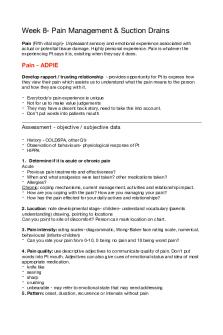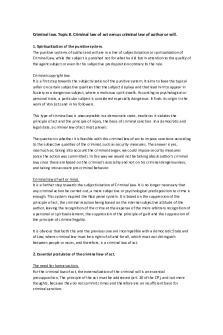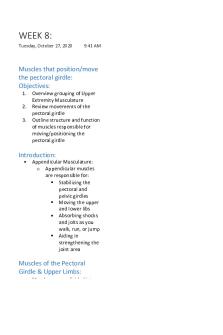(8) Leases - Lecture notes 15-17 PDF

| Title | (8) Leases - Lecture notes 15-17 |
|---|---|
| Course | The law of Property |
| Institution | University of Aberdeen |
| Pages | 10 |
| File Size | 209.6 KB |
| File Type | |
| Total Downloads | 99 |
| Total Views | 183 |
Summary
Lecture notes with some extra reading, Dr Douglas Bain...
Description
Leases 1. Generally A Contract - The general rule is that a lease is a contract ( In personam, e.g. not a real right) per Property type Moveables – may be leased, simply called hire Heritable Lease of land; may become real right (subordinate) by way of Leases Act 1449 Types: - Commercial Ones subject to special staturoy rules; divergence from general and common law on leases: - Agricultural - Residential Definition Rankine, The Law of Leases in Scotland (3rd ed), p.1 “A lease or tack - a contract of location - one person grants and another accepts certain uses, current or definitive, or the entire control, of lands or other heritages - for a period or periods, definite or indefinite, or even in perpetuity, - in consideration of the delivery by the grantee of money or commodities or both, periodically or in lump or in both of these ways. - The granter is known as the lessor, land- lord – and - the grantee is known as the lessee, tenant, tacksman, sublessee, or subtenant. - The periodical payment is rent, royalty, or lordship: the lump sum is grassum or foregift. The contract is in its essence purely personal Sets out terms to know: - Landlord lessor - Tenant Lessee nb. commonly ‘Tenancy’ is used interchangeably with ‘lease ‘ – esp. for residential properties - tacit relocation renewal - Mail rent - Grassum premium, e.g. one off fee at commencement of lease, as opposed to rent - Term duration ; and the end of term ‘ish’ McAllister, Scottish Law of Leases (4th ed), p.3 – “A lease is a contract by which a person, known as the tenant, is allowed to occupy someone else’s heritable property for a finite period. In return for this the tenant pays the person granting this right (ie the landlord) a periodical payment known as rent. Rent usually takes the form of money, but may also (though not commonly) be paid in goods.”
2. Elements They are all “cardinal”; Without one element, there is no lease - even if all present, lack of agreement may preclude lease – Gretton 20.3 However, as well be seen, if 3 out of 4 are present, an element may be implied/imposed by court The “four Ps”: Parties, Property, Payment, Period For a lease to come into existence there needs to be consensus in idem as to four elements – the parties, the subjects, the duration and the rent. - If one is missing, there is no lease; you may have a license, which is a lesser right in contract, personal i. Parties - must be an agreement who is lessor and lessee - Either party may be individual or a joint party - Both natural and juristic parties suffice A lease is bilateral, it requires own lessee and lessor – (as derived from Rankine) - This means the lessor must have both legal capacity, and they must operate within general rules of contract Co-Owners Cannot grant lease - They may contract to give exclusive control, but it wont be a lease; Clydesdale Bank plc v Davidson - Attempt to grant pro indiviso share to co-owner by lease; held not effectual as lease but merely agreement ii. Property Heritable - Land or building (for such, landlord/lessor may not retain natural possession Exclusive Possession - Vital; Lack of exclusive possession means there is no lease Perth Magistrate v Perth and Kinross 1937 SC 549 - City of Perth laid out aerodrome with landing strip; one claimant argued they had a lease Held, because there was no party that had exclusive use to the property, there was no lease
-
Intermittent Possession Often it is obvious when something is not a lease, when one only uses it temporarily, even if there is a set period for how long one may do so Rangers Football Club, Noters 2012 - Holder of season ticket for football had all but exclusive possession defined, as he had set specific seat, but only during matches
NB. if it is a lease of fishing, minerals or other rights – lessor may be able to use property for other than the lease purposes – the lease itself must be exclusive; exclusive use i.e.
Pro Indiviso under Lease - May include granting of pro indiviso rights – a joint real right in ‘neighbouring’ land Gyle Shopping v M&S 2014 CSOH 59 - the grant of a lease in a shopping centre included the real right of a pro indiviso share to a third of a shared area Held, not a personam claim; when the pro indiviso is disjunct from lease agreement it may confer a real right in itself
Specificity - under general rules of law; subject matter must be identified Conway v Glasgow Council - Claimant tried to argue lack of notice when evicted from homeless shelter Held, there was nothing to specific it as a lease (and to give rise to a reg. eviction notice, simply an agreement to use facilities)
Possession Prior to ‘Granting’ - Prior possession may assist satisfying “Property” element; allowing for required level of specificity of the property’s extent to be determined Andert v Johnston 1987 SLT 268 - The fact that the Ds had been in possession for some time, operating the farm Held, allowed reference to the “the land of Hershill Farm” to satisfy specificity of lease
iii. Rent Cannot be Elusory - Bankton, “rent must not be elusory” 2.9.6 Money - albeit usually money, may be any kind of “remuneration”; e.g. fish or other service – Paisley, Land Law, para 7.9 Frequency No set requirement how often rent is paid - Usually payable on monthly basis for residential; and quarterly for commercial
-
As the Least Important Lease Element if the other three elements are present, market rate may be used to set rent (by the courts)
Glen v Roy - Case of a bond owner claiming rent from debtor’s, a dead husband, family for rent arrears Held, there was a lease, and rent could be affixed by “market” e.g. value of property
Requirement to make rent “rent” Periodical Payment - This is important, because it makes grossum (a premium one-off) insufficient Mann v Houston - Claimant had agreement to use garage by single payment Held, this made him not a tenant but there was merely contractual agreement of occupancy
iv. Duration - only, by common law, required for leases to actually have one – Carruther v Irvine: “A lease for as long as the grass growth and water runneth down” Valid “Perpetual leases” Leases can be granted for 999 years Welwood v Husband 1874 I R 507 - The proprietor of a land gave exclusive rights to hunt to a third party; the other party the tenant argued it was not allowed; still holding a valid 999 lease
Limited Durations However, most property’s have limited lease duration; since Land Tenura Reform (S) Act 1974 - “Dwelling Houses” – 20 years Since “Abolition of Feaudal Tenura (S) Act 2000” - cannot have duration over 175 - nb. does not operate retrospectively, long leases created prior still valid Yet Because Long Leases (S) Act 2012; conversion to outright ownership has undergone on appointed day of 28 nov 2015
-
Lack of Specified Duration If there is consensus as to rest of the lease elements, a court may declare the duration to be one year
Gray v Uni of Edinburgh 1962 SC 157 - The Uni tried to lease from pro indiviso proprietors; there was no consensus as to the rent to be paid Held, the claimants, the pro indiviso owners, could not have a declarator of a lease based on having court set duration to 1 year – 3. Lease as Real Right i.
Generally
nb. Above, common law, is only establishing of a contractual lease – a right in personam – cannot be claimed against single successors (as is not in rem) - At common law it was not possible to create real right until Leases Act 1449: Leases Act 1449 - Allows for heritable (look up point on acceded moveables, like machinery, being leased) property to be leased as a real right Happens one of two ways, depends on duration of lease - Lease < 20 years Short lease - Lease > 20 years Long Lease
The In between of Contract and Real right Gretton and Steven 19.10 - “...straddles rather awkwardly the law of real rights and the law of contract” -
Rankine he lease is in its essence purely personal; in certain circumstances it gives rise to what is substantially a real right.” p1 Leases are merely personal contracts – were in certain cases converted into real rights by the operation of the old Act 1449 c.17 as liberally construed by the Court (p.132)
-
Paton and Cameron: P103 Leases has by virtue of 1449 Act allowed the tenant “security of tenure” in question of a singular successor of the grantor Called a real right, it is not a real such - although it has some of the privileges of a real right, does not significantly differ from a mutual contract -
Lord Balgray in Inglis v Paul (1829) 7 S 469 at 472 to say lease is a real right is “most egregious mistake…” It has the effect of being a real right but is totally distinct from real rights – it has these qualities due to “extrinsic and adventitious”
Nemo Plus Rule As with all real rights, the nemo plus rule applies - One cannot transfer title better than one has – Ulpian in Digest, 50,17,54 A Subordinate Real Right: Lease Lease is different to other Subordinate real rights Subordinate Real rights are often described by their burdening of the real right of ownership Contrast Lease: 1) It is an ongoing Contract 2) The lease does not Detract from value of property (unlike servitude, or liferent) A lease “encumbers” property by allowing use/possession; however, this encumberment is also pertinent to the landlord, it creates income for lessor - e.g. Especially commercial properties, the pertinent aspect of having a tenant paying rent makes the property more valuable than if it stood empty
ii.
Formalities
Writing: Governed by Req. of Writing Act 1995 One year or lower lease do not require writing – section 1(7) Leases one year or above requires writing section1(2)(b) nb. Lack of writing just removes conferral of the lease as a real right - remains a valid contract/common law lease iii. The Leases Act 1449 - Operates by extending the requirements of Common law lease, enhancing the four elements, plus adding a fifth, possession
1) Property Any property heritable, which is capable of separate tenement - fresh water fishing right, by way of Salmon and Freshwater Fish (Cons.) (S) 2003 section 66 Separate Tenement and Hunting Rights: - Hunting rights are only able to be separate tenement by virtue of Abolition of Feudal Tenure (S) Act 2000 Section 65Alaw is uncertain Polloc v Harvey - the right of killing game was held real right, but not a separate tenement Palmer’s Trustees v Brown - Case where P sold land, kept hunting rights, argued he could not have registered it (to be able to claim his right as real against the third party) Held, it was applicable to be registered under Registration of leases 1857
2) Rent - Only requirement, rent may not be “illusory” Alison v Ritchie 1730 Mor 15196 - “a tack” let for “elusory tack-duty” (and being of 2400 years duration) was “not benefitted” by the LA 1449 3) Duration - must have a definite “Ish” – Gretton 20.11
4) Possession: The Fifth Element - If the additional LA 1449 requirements are met – and tenant takes possession: This makes the contractual lease/right into a real right Possession - Encompassing, may be natural possession, (by own person) or civil possession, such as one of a representative or sub-tenant Preliminary Possession - Some possession/control of property will not be enough - E.g. maintenance before occupation fails creation of right Millar v McRobbie - C set-up lease for entry on Whitsunday (summertime, May/June) - Knowing outgoing tenant left in march, C used time until entry date to sow crops etc. - Before entry landlord sold property Held, C had not taken possession, and no right had been formed nb. Wouldn’t matter as before entry date however… iv. Long Leases Leases>20 years must be registered Registration of Leases (S) Act 1857 - If a lease is not registered, no real has been created, even if all other requirements have followed However, it remains valid under common law
v.
Leases per Statutory Protection
“At common law a lease is a personal contract, and, as such, is governed by the general law of Contract.” (Paton and Cameron, The Law of Landlord and Tenant in Scotland (W. Green, 1967) 85). A ‘personal’ lease is no less a lease than a lease that has been made a real right. And if a personal lease were to fall within a statutory regime conferring security of tenure, the statutory security might well replicate some of the real rights, for example, in respect of enforceability against singular successors and third parties including the creditor of the landlord, and in other respects exceed them, as in the ability to remain in possession after the expiry of the contractual tenancy. The effect of this is that the statutory security can trump the real right. The point is made in Gordon’s Land Law: “... the tenant may be protected by special legislation. A tenant holding in virtue of the Rent Acts, for example, is protected against anyone except a party with a title superior to that of the landlord from whom he acquired the premises. Similarly, crofters, small landholders and statutory small tenants may claim the protection of the relevant legislation against anyone holding in right of the landlord.” (Gordon & Wortley, Scottish Land Law (3rd ed) 18-147). Secured Tenancies Adrian Stalker points to the situation in respect of Scottish secure tenancies in his book Evictions in Scotland: “In terms of section 41 of the [Housing (Scotland) Act 2001], ‘tenancy’ means an agreement under which a house is made available for human habitation, and ‘lease’ and related expressions are to be construed accordingly. This provision is of some significance, because it appears to preclude any attempt by a landlord in the social rented sector to avoid the Act by creating a license or ‘occupancy agreement’ instead of a lease. Provided the agreement in question makes a house available for human habitation, and it meets all the other requirements of section 11, it will constitute a Scottish secure tenancy or short Scottish secure tenancy, even though it may not amount to a lease at common law.” (Stalker, Evictions in Scotland (Avizandum, 2007) 92). Statutory security of tenure: Residential Tenancies Private Sector (so far) Assured/Short Assured Tenancies - Housing (Scotland) Act 1988 (before which, the Rent (Scotland) Acts, consolidated in 1984) Landlord’s repairing obligation Housing (Scotland) Act 2006 - Security of Tenure; Grounds for Repossession – mandatory/discretionary; Rent review; Succession; Protection from eviction/harassment; Private Sector (soon come) - Private Housing (Tenancies)(Scotland) Act 2016 Public Sector Scottish Secure Tenancy (SST)/Short Scottish Secure Tenancy (SSST) Housing (Scotland) Act 2001 - Exclusions; Security of Tenure; Grounds for Repossession – conduct/management; Succession; Repairs and improvements; The right to buy; Repairs
vi. Rights and Obligations Main right: Tenant's rights to possession against his landlord - The landlord's primary obligation is to give his/ her tenant possession of the subject let - In turn, tenant must enter into possession and actually use property Graham v Black and Stevenson 1792 Hume 781 - if one doesn’t use property, and maintain, it’s a material breach Particular aspects of the obligation to give possession: Tacit relocation implied reletting on the same terms for the same period to a maximum of one year but capable if infinite repetition Assignation - Delectus personae. A lease may expressly allow or disallow assignation. Express provision in the lease settles the question. Where the lease is silent question is whether the choice of the other party in the lease was essential for the contract to be concluded, i.e. did the landlord want a tenant or did the landlord want a particular tenant. In the former case, assignation should be possible. In the latter, probably not. Delectus personae is presumed in residential leases – i.e. the consent is the landlord is requisite for assignation. ALSO Subletting – as per assignation Death of the tenant – - in common law the death of a tenant does not in general terminate a lease. A lease may be inherited. Special rules exist in respect of agricultural and residential leases Break clauses - Specific conditions if not met allows termination of lease – usually the paying of rent Resumption by the landlord the right of the landlord to resume possession after the death of the tenant, i.e. so as to prevent the heir from succeeding to the lease Renunciation by the tenant the tenant giving up the lease on the basis of a material breach on the part of the landlord Irritancy Closely related to rescission by material breach, just more defined - legal – Only the non-paying of rent - conventional, e.g. clauses to allow for irritancy, for example 21 days of not paying rent is for commercial leases Purging of irritancy: being when tenant remedies by fixing what is irritating the agreement Remedies for contravention of terms of lease Tenant Rescission - Perhaps most common place, is if landlord does not maintain the property interdict; specific implement; rent retention, abandonment Kippen v Oppenheim - Allows rescission of tenancy agreement because landlord failed within reasonable time to repair Landlord Rescission - most commonly the non-payment of rent – however, any monetary obligation must allow 14 days for tenant to remedy – Per Law Reform Misc. (S) Act 1985 - as for non-monetary obligation, “it must be fair and reasonable to rescind” - most commonly the non-payment of rent – however, any monetary obligation must allow 14 days for tenant to remedy – Per Law Reform Misc. (S) Act 1985 - as for non-monetary obligation, “it must be fair and reasonable to rescind”
Offside Goal Rule - Allows for the first party in agreement to obtain lease in property, to claim reduction of any subsequent agreement about; even if latter right was made a real right before first agreement Penalising ‘Bad Faith’ - Under general rules of contracting, one cannot contract to purchase/be assigned or granted any right in subject matter which has been “promised” to another under valid contract - So, offside goal rule only applies if the third party knew about prior agreement/right
Rodgers v Fawdry 1950 SC 483 - R had contracted to buy farm of F, but at settlement did not pay up purchase price; Third party B proceeded to contract with F, knowing of prior contract, proceeding on the assurance of F that the contract had fallen through - B proceeded to acquire real right by way of purchase and registration; all whilst knowing R was proceeding and getting ready to take possession and do the same of farm Held, the prior “personal” right trumped the real right acquired by B - No defence for B that F had given assurance Jus ad rem acquirenda - The rule operates when there is a “personal right capable of being made real” - E.g. a contract of lease can be made real, and so can contract of sale Optical Express v m&s 2000 SLT 644 - O had lease with MnS, and argued that new tenant V was prohibited to take occupancy due to that M was bound by a back letter where prev. landlord had, had agreed that O would have the only unit trading as optician, argued it was binding on M as singular successors. Held, not a clause capable of creating real right binding on successors – could not be enforced
1) Transfer followed by subordinate real right - If A agrees transfer to B, then creates subordinate real right, (lease, security, servitude) to C – and this right becomes complete before transfer - Rights may co-exist, and so C could be allowed to enforce the right against B, yet B may be able to reduce Trade Development bank v Crittall Windows - Lyon group were tenants of industrial estate; granted a security to bank, had normal clause of prohibiting the granting of a sub-lease - Lyon did grant such sublease – bank could reduce this real right, - nb. this case illustrates prohibition of the creation of a right by a previous personal right (capable of being made rea...
Similar Free PDFs

(8) Leases - Lecture notes 15-17
- 10 Pages

Topic 8 Leases
- 6 Pages

PFRS 16 Leases - Lecture notes 1
- 18 Pages

8 - Lecture notes 8
- 21 Pages

8 - Lecture notes 8
- 21 Pages

Leases
- 7 Pages

8 Midwifery - Lecture notes 8
- 3 Pages

Taxation 8 - Lecture notes 8
- 2 Pages

Week 8 - Lecture notes 8
- 6 Pages

Dox 8 - Lecture notes 8
- 21 Pages

Lesson 8 - Lecture notes 8
- 2 Pages

Assignment 8 - Lecture notes 8
- 4 Pages

Week 8 - Lecture notes 8
- 23 Pages

WEEK 8 - Lecture notes 8
- 10 Pages

CL-8 - Lecture notes 8
- 12 Pages
Popular Institutions
- Tinajero National High School - Annex
- Politeknik Caltex Riau
- Yokohama City University
- SGT University
- University of Al-Qadisiyah
- Divine Word College of Vigan
- Techniek College Rotterdam
- Universidade de Santiago
- Universiti Teknologi MARA Cawangan Johor Kampus Pasir Gudang
- Poltekkes Kemenkes Yogyakarta
- Baguio City National High School
- Colegio san marcos
- preparatoria uno
- Centro de Bachillerato Tecnológico Industrial y de Servicios No. 107
- Dalian Maritime University
- Quang Trung Secondary School
- Colegio Tecnológico en Informática
- Corporación Regional de Educación Superior
- Grupo CEDVA
- Dar Al Uloom University
- Centro de Estudios Preuniversitarios de la Universidad Nacional de Ingeniería
- 上智大学
- Aakash International School, Nuna Majara
- San Felipe Neri Catholic School
- Kang Chiao International School - New Taipei City
- Misamis Occidental National High School
- Institución Educativa Escuela Normal Juan Ladrilleros
- Kolehiyo ng Pantukan
- Batanes State College
- Instituto Continental
- Sekolah Menengah Kejuruan Kesehatan Kaltara (Tarakan)
- Colegio de La Inmaculada Concepcion - Cebu
